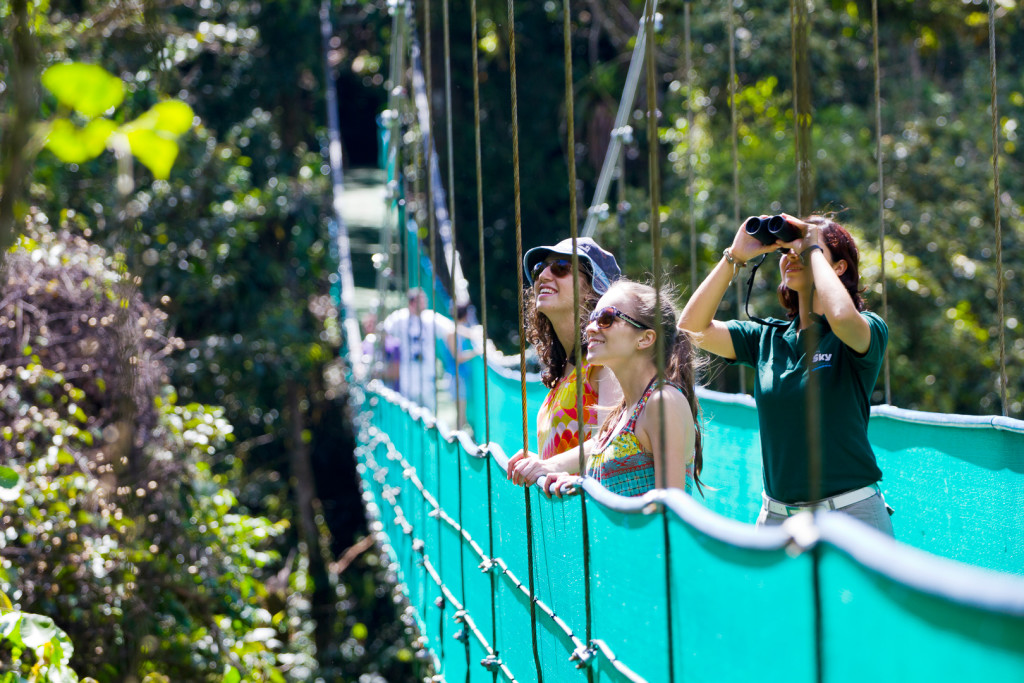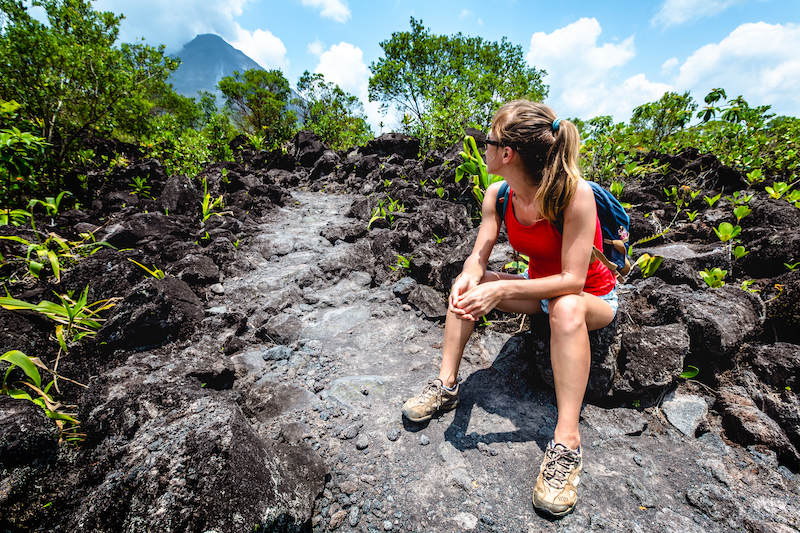Monteverde
Travel Guide
Monteverde’s popularity rose in the 1980’s, when a National Geographic article promoted the area as a mecca for wildlife lovers, especially bird watchers. Now, Monteverde is on almost all travelers’ lists of things to do in Costa Rica. People flock to Monteverde to go ziplining through the famous cloud forest reserve, to observe the innumerable species of wildlife that live here, and to enjoy this unique natural environment on horseback or on foot. There is something to suit every type of traveler in Monteverde, which is why it is as popular with backpackers as it is with wealthy retirees and couples. It is also a favoured haunt of budding photographers, who will find an endless array of subject matter to capture with their lens.

What not to miss
Don Juan Forest Twighlight Walk Top
The Don Juan Coffee Tour and Twilight Walk will give you the chance to learn about the growth and process of Costa Rican coffee beans in a volcanic area, while also enjoying the magical experience of hearing and seeing the transition from day to night in a tropical cloud forest. Your Coffee Tour with the Twilight walk that begins at 18:00. This is the time that the sun is starting to fall and the light mystically disappears from the sky, leaving you in the peaceful darkness of the jungle. By nightfall, more than 60% of the forest life awakens, but not before the wildlife of the day shift rushes through the forest to find a final snack before going off to bed. This allows you to observe, guided by a bilingual naturalist guide, a great diversity of mammals, insects, amphibians and reptiles. Especially the dart frogs awaken at night, allowing you to observe them in their most active manner with their bright colors and night chants. You will also be able to see: tarantulas, wolf spiders, lizards, coatis, agoutis, two-toed sloths, olingos, kinkajous, opossums and a great diversity of birds either asleep or on the lookout. The focus on this part of the tour will be on the sounds and scents of the jungle, giving you a true encounter with nature while allowing you to see different endemic species of Monteverde.
Don Juan Coffee Plantation Top
The Coffee Plantation Tour gives you the opportunity to learn about the growth and process of coffee beans in a volcanic area. The interactive tour is held on the Don Juan coffee plantation. You will be guided to the coffee plantation in operation to learn how coffee is roasted and how the production and processing of coffee transform coffee beans into a drink with a delicate flavor to the coffee makers taste. Coffee is a very important product for the Costa Rican economy and interwoven in the culture of every Tico. Therefore the focus in this part of the tour will be on the history and tradition of Costa Rican coffee. During the coffee tour you will learn how the authentic Costa Rican coffee used by the grandparent’s generation was made and how this tradition turned Costa Rica into a country known for its peace and progress.
Sky Tram, Sky Trek & Sky Walk Top
Today you will enjoy the beauties of the Monteverde Cloud forest and the surrounding area, on a combination of one of the most famous activities in Costa Rica; the so called Hanging Bridges Hike or Sky walk and Canopy Zip-Line or Sky trek. The Sky Walk and Trek are combined with a ride in the Sky Tram (gondola) that provides for an unforgettable full day excursion. First, a ride in an open-air gondola, the Sky Tram, will take you up into the Monteverde Cloud Forest to the highest observation point in the area, also called the Continental Divide, where you will have some time to admire the view of the Nicoya Gulf, the mountain range and the Cloud Forest. From this area, your nature guide will take you on a hike to explore the treetops walking on suspended bridges that span across canyons and through the canopy bringing you face to face with the upper level of the Cloud Forest. Later we start the adrenaline pumping part of your Cloud Forest adventure. With 1.7 miles of cable slung between towering trees, stretching across canyons and between the treetops, you’ll set off on a heart pounding zip-line, whizzing through this amazing environment. You’ll zip your way from lofty platform to lofty platform as you work your way down to the starting point at ground level. Although you’ll be moving too fast to see much of the wildlife on this part of the tour, it’s definitely a thrill worth experiencing and without a doubt one of the most thrilling zip lines in the country!
Monteverde ATV 4 Wheeling Adventure Top
This ATV tour is an unforgettable and muddy tour through the gravel roads of Santa Elena and along various private trails. The adventure begins with a short talk on the basic driving concepts before it’s then time to mount your powerful four-wheeled machine, as you follow a friendly and professional guide, who will take you through the beautiful rolling countryside on the outskirts of Santa Elena. Your expert guide will ask if you prefer a mellow, slow-paced tour or a faster more exhilarating, off-road adrenaline experience, to make sure that you will get what you want out of this tour. The ATV tour will take you splashing through streams and mud, tearing through narrow, windy trails characteristic of the Monteverde Cloud Forest, and inching your way down rocky, dirt roads impossible to reach by regular vehicles. After two action packed hours on these ‘cuadraciclos’, as they are called in Spanish, you will remember this trip for the rest of your life. At the end of the tour you will be transferred back to your hotel.
Monteverde Bird Watching Top
Led by an expert naturalist guide, we bird around gardens and forest edges before getting to the deep forest for the specialists inside of the chosen reserve. This could be either the: Monteverde Reserve, Santa Elena Reserve or the Curi Cancha Reserve. Therefore we maximize the micro-ecosystems and the numbers of species. Bird species in Monteverde migrate in altitude constantly and somehow unpredictably. Our provider offers expert guides who monitor these movements daily so they can play by ear and even recommend changes of where to go according to particular goals and interests.
Monteverde Nature Walk Top
The Monteverde Reserve, Santa Elena Reserve and Curicancha Reserve are all located in this area, you will be picked up from your hotel by your expert nature guide and taken to the Reserve of your choice. Along the way to the reserve your private guide will point out interesting facts about the natural environment as well as provide you with some of the history and culture of Monteverde which was founded in 1950 by 12 American Quaker families, who began farming dairy cattle in the area and protected the local environment. This way you will already have some interesting insights before starting your 3 hour hike through the Cloud Forest. Tropical forests are some of the most biodiverse and least studied and understood in the world. There are 2,500 species of plants in Monteverde, including moss, bromelia and fern and 420 kinds of orchid, as well as monkeys, sloths and more than 400 bird species such as the endangered three-wattled bellbird, the famous resplendent quetzal, tanagers and hummingbirds of which there are 30 kinds in this area alone!
Monteverde Reserve Twilight Walk Top
At nightfall, a new world awakes in the cloud forest. Large numbers of wildlife are more active at night than during the day, showing a different world from frogs to the mysterious nocturnal bats that are part of the Biological Reserve of Monteverde’s Cloud Forest. Your twilight hike through the Monteverde Cloud Forest is a great chance for those who wish to experience the nocturnal biodiversity of the tropical forest led by a professional naturalist guide who will take you to the best spots for spotting wildlife and be on hand to answer any questions about this unique natural environment.
Trapiche & Coffee Tour Top
Learn about the growth and process of coffee beans as well as sugar cane, chocolate, bananas, plantains, tubers, oranges and more in a volcanic area. The interactive tour is held at El Trapiche, a Costa Rican family business where you can enjoy a 2 hour tour of an authentic farm. You will be guided to the coffee plantation in operation to learn how coffee is roasted and how the production and processing of coffee transform coffee beans into a drink with a delicate flavor to the coffee makers taste. Coffee is a very important product for the Costa Rican economy and interwoven in the culture of every Tico. You will also be invited for a ride in a traditional Costa Rican ox cart, watch the process at the sugar mill of making liquor out of sugar cane and learn about the process of preparing chocolate from cacoa.

Fast Facts on Monteverde
USEFUL TRAVELER INFORMATION
When to go
Monteverde’s dry season runs from December to May and, as with the rest of Costa Rica, this is the busiest and most expensive time to visit. The wet season is between May and December, with August to November experiencing quite a lot of rainfall, making it undesirable for hiking and trekking. The best time for birding watching is between February and May, when flocks of birds migrate to the area to nest. Regardless of the time of year, the weather in Monteverde is fairly predictable in that it is usually wet and somewhat chilly, and it is common to encounter cold nights and misty, damp and cool days. Temperatures do not vary much throughout the year, and stay between 16 and 29 degrees Celsius most of the time.
How to get there
Flights to Buenos Aires come into two airports: Ministro Pistarini Airport (better known as Ezeiza EZE) is the international airport and is located about 22 miles (35 km) outside the city. Jorge Newbery Airport (better known as Aeroparque AEP) operates domestic and regional flights coming to and from Chile, Brazil, Uruguay and Bolivia, and is located in the centre of the city near the coast. Buenos Aires is separated from neighbouring Uruguay by the Rio de la Plata, and ferry services run between the quaint village of Colonia del Sacramento and the capital Montevideo. Domestic flights are plentiful in Argentina, and Buenos Aires connects to most major touristic destinations. New low cost air carriers have made flying internally cheaper in recent years, but all of your transfer flights will be arranged for you as part of your itinerary, so we will take care of the bookings.
Infrastructure
Buenos Aires has something to cater for everyone. In recent years, as tourism to the city has increased rapidly, the tourism infrastructure has vastly improved, and now there are plenty of high-end hotels, boutique accommodations and stylish apartments to stay in, depending on your travel goals. We can advise you on every type of accommodation, so just consult with one of our travel advisors and we can tell you what is on offer. Buenos Aires has a vast public transport network should you choose to live like a local and take the colectivo, or bus, or the Subte, the subway system. Taxis are abundant and more affordable than in many other capital cities, but traffic in Buenos Aires can be bad, and public strikes can often send the city into lockdown. If you are a fan of two wheels, there are lots of bike lanes around the city, and it is surprisingly flat, easy and safe to cycle around. Beware of pickpockets when you are out and about, and leave all your valuables, including jewelry, extra cash and credit cards at home.


Tour Packages to Monteverde





